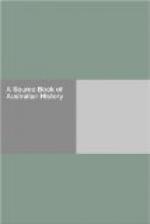Mr. Bass returned at half past two, with a boat-load of seals and albatrosses. He had been obliged to fight his way up the cliffs of the islands with the seals, and when arrived at the top, to make a road with his clubs amongst the albatrosses. These birds were sitting upon their nests, and almost covered the surface of the ground, nor did they any otherwise derange themselves for the new visitors, than to peck at their legs as they passed by. This species of albatross is white on the neck and breast, partly brown on the back and wings, and its size is less than many others met with in that sea, particularly in the high southern latitudes. The seals were of the usual size, and bore a reddish fur, much inferior in quality to that of the seals at Furneaux’s Islands.
Albatross Island, for so it was named, is near two miles in length, and sufficiently high to be seen five or six leagues from a ship’s deck: its shores are mostly steep cliffs.
The north-west cape of Van Diemen’s Land, or island as it might now be termed, is a steep black head, which, from its appearance, I call Cape Grim. It lies nearly due south, four miles from the centre of Trefoil, in latitude 40 deg. 44’; the longtitude will be 144 deg. 43’ East, according to the position of Albatross Island made in the Investigator. There are two rocks close to Cape Grim, of the same description with itself. On the north side of the Cape the shore is a low sandy beach, and trends north-eastward three or four miles; but whether there be sufficient depth for ships to pass between it and Barren Island, has not, I believe, been yet ascertained. To the south of the Cape the black cliffs extend seven or eight miles, when the shore falls back eastward to a sandy bay of which little could be perceived.
1799. To the strait which had been the great object of research, and whose discovery was now completed, Governor Hunter gave, at my recommendation, the name of Bass Strait. This was no more than a just tribute to my worthy friend and companion, for the extreme dangers and fatigues he had undergone in first entering it in the whale-boat, and to the correct judgment he had formed from various indications, of the existence of a wide opening between Van Diemen’s Land and New South Wales.
THE INVESTIGATOR
+Source.+—Voyage to Terra Australis (Matthew Flinders, 1814), pp. 36-37, 60-61, 211-220, 229-231
In recognition of his services Captain Flinders was given command of the Investigator in which to prosecute the exploration of Terra Australis. He sailed along the South coast and up the East, to Port Jackson: subsequently, he circumnavigated the continent and suggested its present name.
October 16th, 1801. At daybreak we expected to see the highland of the Cape (of Good Hope), but the weather being hazy, it could not be distinguished until eight o’clock.




